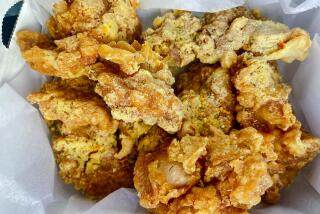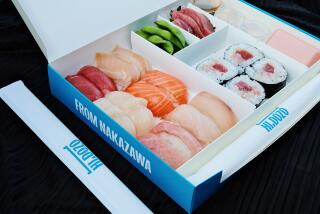Doing Business : Japanese Acquire Taste for Col. Sanders’ Recipe : Partners’ patience pays off as Kentucky Fried Chicken opens 1,000th restaurant in Japan and surpasses $1 billion in sales.
- Share via
TOKYO — Kentucky Fried Chicken recently opened its 1,000th shop in Japan, surpassed $1 billion in sales and will be selling the equivalent of 64 million chickens here this year, or more than one for every two Japanese.
But when the chain launched its business here in 1970, there were few hints of such success.
The Japanese did not know what “fast food” was. Chicken usually meant yakitori (grilled chicken parts on a skewer) or karaage (chicken cooked in vegetable oil). Mashed potatoes and gravy, a staple at U.S. outlets, was an alien intruder to the Japanese palate.
Shops mimicked their U.S. counterparts--buildings with red-and-white roofs and their own parking lots--despite the fact that “there were few car owners in Japan in those days,” said Takeshi Okawara, president of Kentucky Fried Chicken Japan.
What’s more, Kentucky Fried Chicken was charging 280 yen ($2.24 at the current exchange rate) for two pieces of chicken, a roll and cole slaw--”the minimum lunch you would need to fill up your stomach,” according to Okawara. Meanwhile, “a bowl of ramen (noodles) cost 120 yen (96 cents),” he said.
“Our first three shops set targets of 200,000 yen ($1,600) a day in sales--but actually achieved as little as 7,000 yen ($56) a day,” Okawara said.
Indeed, the familiar figure of Col. Harland Sanders that stands in front of nearly every store might easily have disappeared from Japan.
“After a year, we were 100 million yen ($800,000) in the red,” Okawara said. Heublin Inc. had just taken over the U.S. parent company, but “fortunately, they were so busy getting themselves established that no one watched the red ink here.”
Subsequently, the U.S. ownership changed hands twice more, with soft-drink giant Pepsico Inc. finally taking over. But throughout those years, the Japanese partner in what started as a 50-50 joint venture was the giant trading company Mitsubishi Corp.
Its involvement stemmed from its large imports of feed grain from the United States, said Enshiro Matsuyama, senior managing director for foods. Those transactions, in turn, led the company into the poultry-raising business in Kyushu in 1969. From there, the joint venture with Kentucky Fried Chicken followed as “a natural development” in 1971, he said.
It was, nonetheless, Mitsubishi’s first plunge into what he jokingly called “mizu shobai”-- literally, “water business,” a term normally used for bars and nightclubs where employees deal directly with customers. Mitsubishi had never sold anything directly to consumers before.
Unlike Heublin, Mitsubishi noticed the mounting red ink. But Matsuyama said the company was interested in Kentucky Fried Chicken from a long-range point of view.
“We were not looking at the quarterly results, as they do in the United States. And the losses were absorbable from our point of view,” Matsuyama said. (Indeed, Mitsubishi’s sales amounted to $145 billion last year.)
Three Mitsubishi executives now serve on the Kentucky Fried Chicken Japan board, including one who is the chairman. The trading company also provides the chain with 60% of the chicken meat it sells here and serves as its agent to import flour, shortening, potatoes, corn and machinery for its stores.
According to a Harvard Business School study, Mitsubishi’s continued financial support during those early days was crucial as the Japanese chain wound up closing two of its first three shops and laying off half of its 40 permanent employees.
Okawara, who quit a job with a large Japanese printing company to join Kentucky Fried Chicken Japan at the start, recalls moving equipment from an unsuccessful store in Nagoya to Kobe and, along with four other original employees still with the company, taking charge of the new shop.
Lacking funds to pay for hotel bills, “we slept in the back of the shop on flour bags. Our ‘showers’ consisted of washing ourselves from the sink in the kitchen,” Okawara said, recalling how greasy he felt.
Ultimately, “that was the first shop to show a profit,” he said.
French fries replaced mashed potatoes. Small shops, located in “back streets near shopping areas where the rents were cheaper,” replaced U.S.-style buildings. Some were so tiny that the food-preparation area was called a “submarine kitchen”--as small as what you might expect on a submarine. Even today, “in about 10 of our shops at peak hours, we have to supply oxygen to our kitchen workers,” Okawara said.
Col. Sanders came to Japan three times in his capacity as “goodwill ambassador” for Kentucky Fried Chicken, and all kinds of gimmicks were tried to attract customers. At Christmastime, employees donned Santa Claus suits and propagated the idea that there was no better way to celebrate Christmas--in this non-Christian country--than eating fried chicken.
Not until 1976, when 130 shops were in operation, did the joint venture show a profit--of 14 million yen ($112,000). Last year, profits amounted to 4.7 billion yen ($38 million) on sales of $534 million from direct operations of 321 shops and fees from 666 others operated by qualified franchisers.
(Franchisers report their Kentucky Fried Chicken sales, but not their profits, to the joint venture corporation here. Including the franchise shops, chain sales last year reached 137.9 billion yen, or $1.1 billion.)
Increased volume helped lower prices relative to the competition. Ramen, for example, now sells for around 500 yen ($4), while a standard Kentucky Fried Chicken meal is priced at 480 yen ($3.84). And the Santa Claus gimmick proved so successful that customers now must order, pay in advance and book a pickup time to get a meal on Dec. 23, 24 or 25, Okawara said.
For Mitsubishi, too, the investment has paid rich dividends. The joint venture now ranks among the trading company’s top 10 subsidiaries. And in 1990, when the two partners reduced their stock holdings to 30% apiece and sold the remainder to the public, it reaped half of a windfall of 10.4 billion yen ($83.2 million) in new equity. The other half went to the parent, Kentucky Fried Chicken Corp.
Today, Kentucky Fried Chicken is looking ahead to new vistas in Japan--a tie-up with Pizza Hut (another Pepsico subsidiary) that will offer home-delivered fried chicken for the first time, kiosks in supermarkets and new outlets in amusement parks, railway stations and airports, Okawara said.
The 1,000th shop, opened in July, is the first to be located in an airport--in Sapporo on the northernmost island of Hokkaido.
Although McDonald’s, with 882 shops, is the leader in Japanese fast food with 207.7 billion yen ($1.7 billion) in sales last year, Kentucky Fried Chicken’s 1,000 outlets outnumber all other food chains. It has four or more shops in each of Japan’s 47 prefectures and 153 in Tokyo alone.
Okawara said he sees the potential for an additional 1,200 shops. The joint venture, he added, intends to continue opening between 90 and 100 outlets a year for the foreseeable future. Sales rose 30% in the first half of 1992, he said.
While growth in the hamburger business in Japan has started slowing down, forcing McDonald’s and its imitators to introduce new Japanese-style products to menus, Kentucky Fried Chicken, Okawara insisted, still finds growth in its main product--chicken.
Kentucky Fried Chicken’s biggest change, he said, will come from its entry into the steam-baked chicken business under the name “Kentucky Fried Chicken Harvester Club”--a response to a health wave that has spread through the food business in Japan. Its first “Harvester Club” shop opened recently in Tokyo.
As a concession to Japanese preferences, the chain will also add rice to the menus at both Kentucky Fried Chicken and Harvester Club outlets. It will be served as o-nigiri (rice balls).
Even though Kentucky Fried Chicken helped change the eating habits of Japan, Okawara says it did not change the trading habits of the United States.
While Kentucky Fried Chicken would like to buy more of its chicken meat from the United States--where the cost of raising poultry is 30% less than in Japan--it has been frustrated by what the Japanese executive described as recalcitrant U.S. poultry farmers.
A $2-million experiment in importing frozen U.S. chickens in 1988 was a disaster, Okawara said. U.S. slaughtering procedures left too much blood in the chicken, and farmers refused to tailor their methods to meet Japanese tastes, he said. They did not provide a standard size of chicken, foisting on the Japanese chain chicken parts that were too small to use. Because they considered exports a “side business,” the U.S. poultry companies also delayed freezing chicken they originally had hoped to sell fresh in the United States. As a result, Okawara said, “some of the meat smelled when it was cooked.”
U.S. poultry companies “only want to export their surplus chicken parts,” agreed Yuji Nagi, Japan director of the U.S. Poultry and Egg Export Council, which promotes exports of frozen chicken to the Japanese market as a whole. Last year, those exports were valued at $170.1 million.
Okawara said the joint venture hasn’t given up trying to get U.S. producers to ship to its specifications. “If we are to grow here, we must import” cheaper foreign chicken to combat rising costs in Japan of such items as wages, Okawara said. The average hourly wage in Tokyo for part-time workers is $8, he said.
As of now, however, Kentucky Fried Chicken buys only $10-million worth of U.S. processed chicken, such as ground meat for patties, Okawara said. Imports of French fries, canned corn and paper products bring total purchases from the United States to slightly less than $33 million, he added.
Sales of U.S. products to Japan that the chain stimulates indirectly--such as feed for the chickens its buys here--add another $65.9 million worth of purchases.
The total, however, is less than a tenth of the chain’s Japan sales.
In the meantime, the Japanese chain has started importing from Brazil. Unlike the Americans, poultry raisers there, Okawara said, have “adjusted to Japanese consumer preferences.”
Fast Food, Fast Growth Kentucky Fried Chicken’s overseas operations have grown dramatically since 1980.
Restaurant Count Retail Sales, in millions Source: Kentucky Fried Chicken Corporation
More to Read
Inside the business of entertainment
The Wide Shot brings you news, analysis and insights on everything from streaming wars to production — and what it all means for the future.
You may occasionally receive promotional content from the Los Angeles Times.










